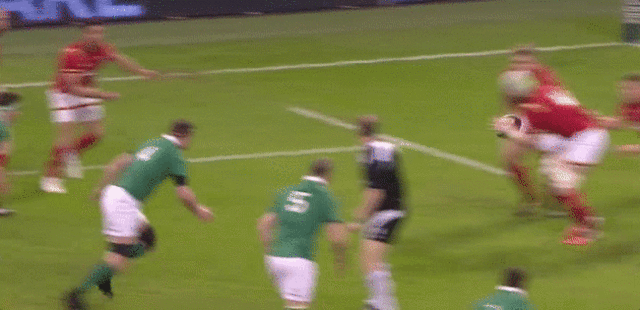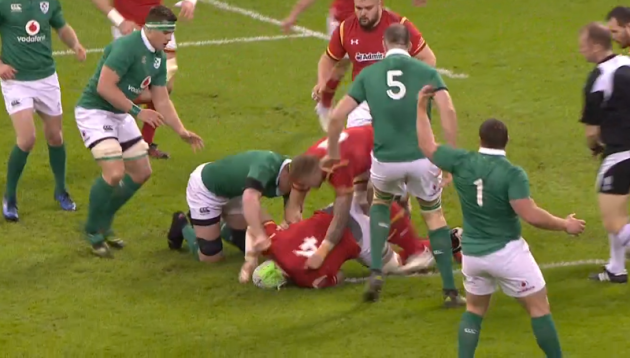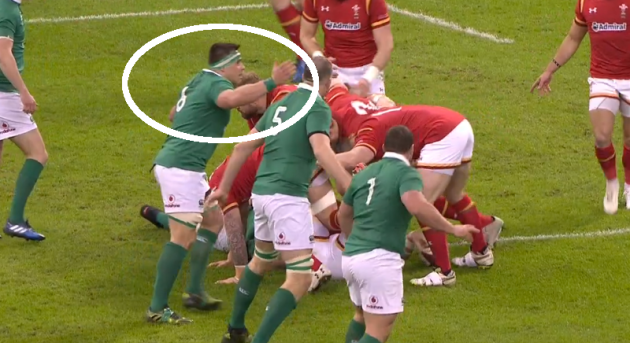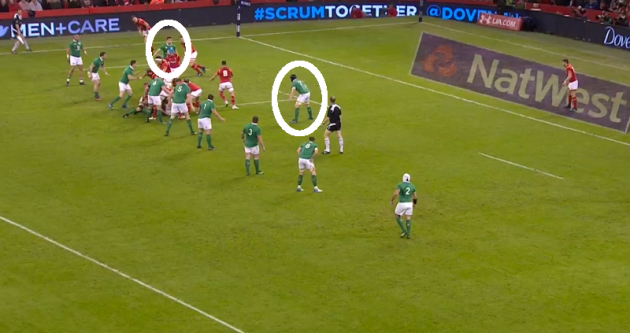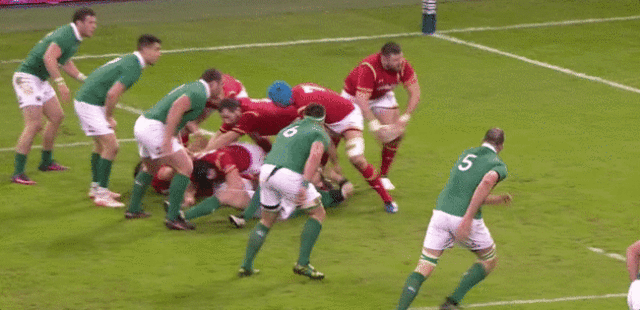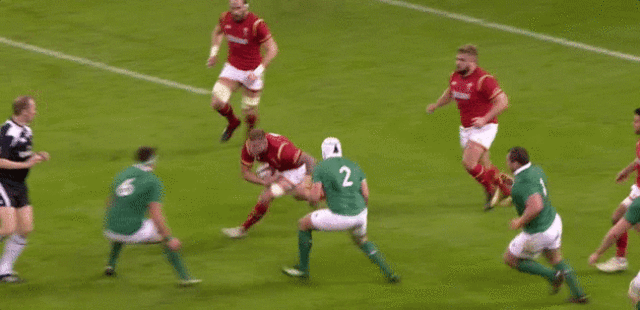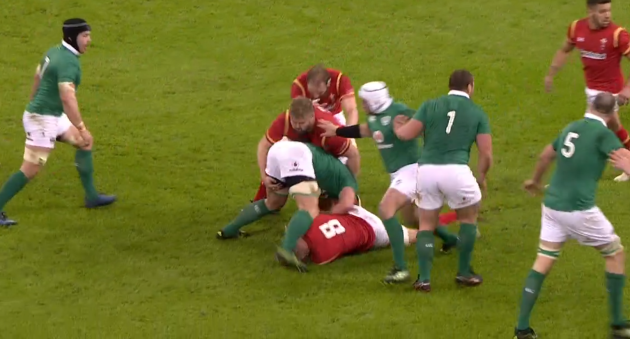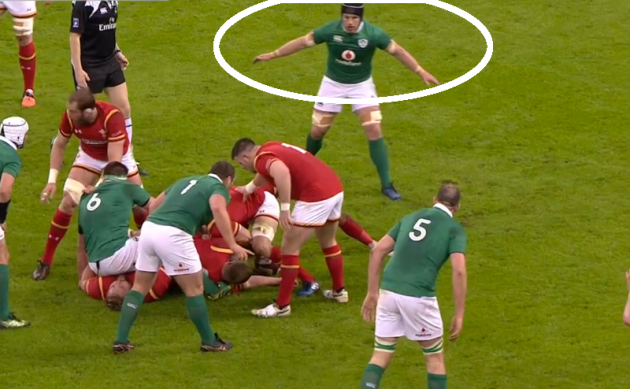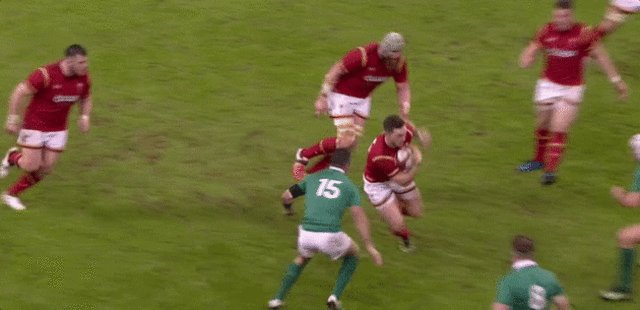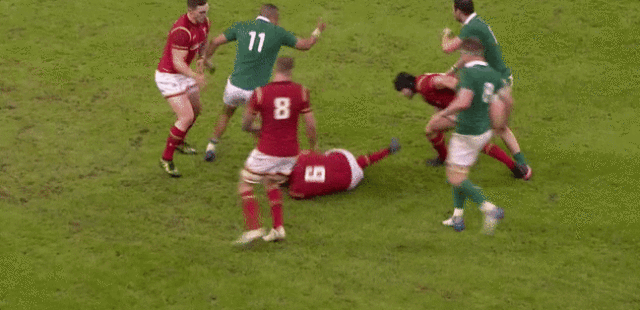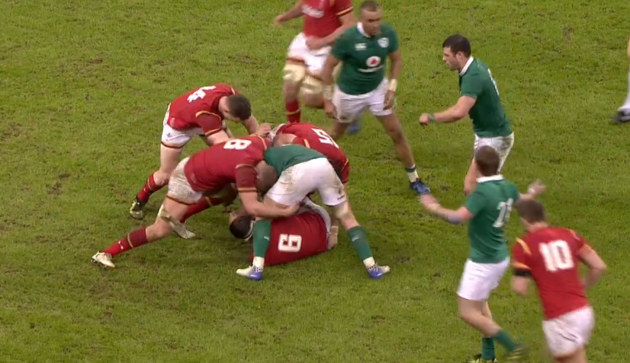IT WAS ALWAYS likely that Italy’s use of the ‘tackle only’ tactic against England in round three of the Six Nations would spark others into giving it a go.
Amateur teams around the world have been refusing the ruck in recent weeks, while it has been mimicked by several professional sides, with Joe Schmidt’s Ireland among the latest to attempt it.
Sean O’Brien was the chief culprit in this area of Ireland’s game against Wales on Friday night in Cardiff, but the Tullow man didn’t quite get the reward he was hoping for with his efforts.
The first instance comes below, in the second minute of the game and with Wales looking to exit their 22 for the first time.
Jake Ball carries off a Rhys Webb pass infield and away from the touchline, with Donnacha Ryan tackling the Wales lock to ground.
As soon as Ryan has completed the tackle, O’Brien is screaming, “Tackle only!”
Indeed, that’s exactly what the situation is below.
CJ Stander does briefly put his hand on Ross Moriarty, who is arriving over the tackle for Wales, as we see below.
It’s arguable whether Moriarty is actually ‘on his feet’ here in the first place, but Stander is keen not to allow Barnes to read this as a ruck situation, so he instantly removes his hands and shows the referee that he has done so.
Remember, to form a ruck – and therefore the offside line – we need one player from each team on their feet, in physical contact, closing around the ball on the ground.
While Stander’s hands do come into contact with Moriarty briefly, he’s not making a genuine effort to come into a contest over the ball and Barnes appears to be satisfied there is no ruck – even if he doesn’t say anything to that effect.
At this stage, O’Brien has screamed, “Tackle only” four times and, despite not getting any confirmation from Barnes that that is the case, he proceeds up and around the tackle area, making sure he doesn’t approach Wales scrum-half Rhys Webb.
Over on the other side of Webb, Conor Murray advances and Ireland have created something of a wall around the Welshman.
There is still some uncertainty here for Ireland, with Jack McGrath to the right of the tackle staying in an ‘onside’ position and asking Barnes, “Tackle only?” just before Webb picks the ball up.
Barnes doesn’t provide any confirmation for Ireland either way, but he allows play to continue and it’s clear that Webb’s options are limited here.
O’Brien is in a good position to block or intercept a possible pass backwards to out-half Dan Biggar, while Murray is closing off passing or sniping space to his right.
Remember, O’Brien and Murray cannot approach the ball, as that would mean entering the one-metre ‘tackle zone’ around the tackle without coming through the ‘gate’ – penalty against Ireland.
While it was always likely that Webb would have box kicked from this position anyway, Ireland’s tactics appear to slightly fluster him and his kick is poor, low and straight into the waiting arms of Keith Earls to run back at Wales on kick return.
Ireland can count this first use of the tackle only tactic as a promising success.
Two minutes later, O’Brien calls, “Tackle only!” again as Wales build another exit, but does so before the tackle on Rob Evans has even been completed.
As we see above, Stander recognises the opportunity for a turnover and jackals, with the arriving Welsh players engaging with him over the ball to form what is clearly a ruck.
Stander is unlucky not to win the turnover or a penalty, with Wales just doing enough to cling onto possession.
O’Brien’s next effort comes in the ninth minute, again as Wales look to build up to an exiting kick out of their 22 – clearly underlining that Ireland have decided to attempt this tactic specifically in this area of the pitch, as the Chiefs did when they first used it in Super Rugby in 2015.
This time, however, O’Brien gets it wrong and the result is a damaging penalty against Ireland.
Moriarty is the ball carrier for Wales off a well-executed lineout five metres from their tryline and he powers into the tackle of Stander, who puts him to ground.
Crucially, though, Stander remains on his feet and then looks to jackal over the ball again.
As soon as Tomas Francis arrives in to clear Stander away, we have a ruck.
“A ruck is a phase of play where one or more players from each team, who are on their feet, in physical contact, close around the ball on the ground,” says the World Rugby lawbook.
We clearly have that here and, as we know, a ruck forms the offside line.
O’Brien, however, misreads the situation and advances up beyond the tackle to a position in behind Webb.
O’Brien shouts, “Tackle only” three times as he comes around in behind the ruck, apparently trying to guide Barnes into viewing it as such.
However, Barnes has identified the formation of a ruck and briefly says, “Out, out” to O’Brien, seemingly warning him to get out of the position he’s in.
Webb passes the ball a second later and Barnes immediately whistles for the penalty against Ireland, providing an instantaneous reasoning.
“Offside, clearly a ruck,” says Barnes, before pointing at Stander. “He made the ruck, he made the ruck. Six is over the ball, there’s contact over the ball.”
Jamie Heaslip shouts something inaudible after Ireland have backed away, but Barnes says, “No, I’m not talking, I’ve made the decision, alright.”
However, after Wales kick to touch for the lineout, Barnes moves to O’Brien to clarify.
“He [Stander] got back up, did he?” asks O’Brien.
“He [Stander] was just on the ball having a contest, so when they made contact, there’s your ruck,” explains Barnes.
Case closed, and from the resulting lineout, the Welsh go 50 metres upfield into the Ireland 22, forcing Joe Schmidt’s men to make a handful of thunderous tackles, before Jonathan Davies knocks on to end a lengthy passage of intense pressure.
While Barnes could perhaps have provided O’Brien with a greater degree of warning in this instance, that’s not exactly his job. Some teams would expect the referee to call “ruck” when a ruck has been formed or “tackle only” when no ruck has been formed, though this is not really the referee’s duty.
If Ireland are going to use what remains a relatively risky defensive tactic, they simply must nail their execution and reading of each situation.
From the restart of the second half – taken by Simon Zebo in Johnny Sexton’s absence – Ireland opted out of a possible ruck, as we can see below.
However, there seemed to be uncertainty about advancing up after O’Brien’s penalty concession in the first half, and we can see that only scrum-half Murray makes a move up around the tackle, although it’s rather half-hearted.
There was another brief Irish attempt before the end of the game, although it involved O’Brien misreading the play again – or at least pretending not to realise that a ruck had been formed.
We see the incident below.
O’Brien advances up the right side of the tackle for Ireland, again shouting, “Tackle only!” twice and pointing to Jamie Heaslip on the ground.
Based on the clip above, it looks like O’Brien is correct, but Barnes tells him, “Get out, get out” and O’Brien halts his movement upfield.
Again, the referee is correct here, as we see when rewinding play a few more seconds to note Heaslip’s initial involvement.
Sam Warburton has gathered in a loose ball after Leigh Halfpenny drops a Johnny Sexton bomb, and Heaslip jackals over the ball.
As soon as the Welsh players arrive and make contact Heaslip – all of them on their feet – there is clearly a ruck formed.
Again, Heaslip probably felt he was unlucky not to win a turnover penalty here, but the point is that O’Brien himself actually identifies the ruck, shouting, “Release, release, release” as Heaslip competes for the steal.
Moriarty and Halfpenny manage to remove Heaslip, Barnes warning, “Off your feet now, Jamie” and the Ireland number eight releases the ball.
But just because Heaslip is now on the ground does not mean that the ruck – or more importantly, the offside line – doesn’t exist anymore.
By advancing up around the ruck anyway, O’Brien has either completely misread the situation, or is aware of the scenario and is attempting to convince Barnes that there is no ruck.
When Wales clear to touch, Barnes again approaches O’Brien and gives him a warning.
“Mate, I don’t want to penalise you,” says Barnes.
“He [Heaslip] is on the ground, isn’t he?” says O’Brien.
“No, if Jamie is on his feet originally, as soon as there’s contact over here, don’t run that risk,” replies Barnes.
It will be interesting to note if Ireland use this tactic against England in Dublin on Saturday, but they will certainly need to be sharper in their execution if it is to be a success.
Subscribe to The42 Rugby Show podcast here:
